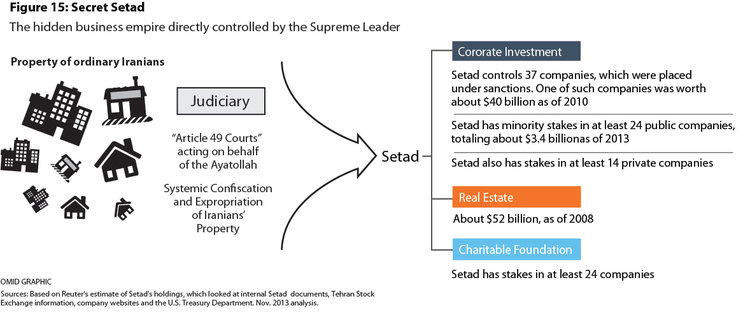THE AHMADINEJAD ERA: THE IRGC AND THE OIL SECTOR
President Ahmadinejad’s political grandstanding—his defiant claims that Iran will not retreat one iota from its nuclear program—masked a much darker reality.
In much the same way that the hostage crisis had paved the way for the capture of the Iranian state in 1979, the nuclear crisis set the stage for another coup in 2009—a power and money grab by the Islamic Revolutionary Guard Corps (IRGC). Under the guise of evading sanctions, an oil mafia with ties to the IRGC, and acting with the blessing of Iran’s supreme leader, consolidated its grip over the Iranian state.
Billions in no-bid contracts were awarded to the IRGC by the Petroleum Council that Ahmadinejad had established in the Oil Ministry in 2006. Yet, despite the significance, scale and volume of these contracts, Iran’s oil and gas sector operated as a closed and incestuous system rigged in favor of insiders. Under the guise of “destroying Israel” and defending Iran’s nuclear program, Ahmadinejad and his IRGC cronies positioned themselves to benefit from sanctions. All they had to do was to sell Iran’s oil, in unknown quantities, at a discount and pocket the difference by importing goods at a premium. For these thieves of state, Iran’s nuclear program—the shadow of sanctions—served as both the excuse and opportunity for pillaging Iran’s oil sector.
- Further reading: Pages 42-50 of Where Is My Oil? Corruption in Iran's Oil and Gas Sector
LABUAN CONNECTION: ZANJANI, NAFTIRAN, INTERTRADE COMPANY AND STANDARD CHARTERED
While serving in the military in the 1990s, Babak Zanjani was assigned as the chauffeur for the head of the Central Bank of Iran. Before long, he headed an $13.5 billion empire of 60 companies, including several financial institutions and a “fleet of oil tankers.” Iranian officials turned to Zanjani to export more than $17.5 billion in oil and bring the money back into the country.

Tankers full of Iranian oil sailed to Labuan where upwards of 24 million barrels of oil would be transferred to conceal its origins and then sold on the open market to buyers in India, Singapore and Malaysia.
Turkey was another perfect place for Zanjani to sell oil and launder money. Cash payments for oil were deposited in a Halkbank account in Turkey. That money was used to buy gold, which was then sent to the Dubai free-trade zone. But Zanjani was not the mastermind. He merely stood at the intersection of much larger interests and networks. Naftiran Intertrade Company, the offshore trading arm of the NIOC, diverted billions of dollars in Iranian oil revenues through banks, companies and trading houses around the world. Zanjani was only one of these agents.
- Further reading: Pages 50-53 of Where Is My Oil? Corruption in Iran's Oil and Gas Sector
THE AYATOLLAH'S CIRCLE: THE SETAD—AN INSTRUMENT OF THEFT
Ayatollah Khamenei’s dictatorial control of politics and the military are obvious, but much of his power is hidden in the machinations of his economic empire.
Iran’s supreme leader controls a vast fortune under Setad, short for Setad Ejraiye Farmane Hazrate Emam (Headquarters for Executing the Order of the Imam). Setad manages the systematic seizure of thousands of properties belonging to ordinary Iranians. As Reuters put it, “The organization [Setad] holds a court-ordered monopoly to taking property in the name of the supreme leader and regularly sells the seized property at auction or seeks to extract payments from the original owners.”


- Further reading: Pages 54-56 of Where Is My Oil? Corruption in Iran's Oil and Gas Sector
THE SANCTIONS WINDFALL: AN ECONOMIC MIRAGE
In 2016, shortly after the nuclear agreement, the United States allowed victims of terrorist attacks to sue Iran for $2 billion in compensation from frozen Iranian funds.
The $2 billion deduction from Iran’s expected sanctions windfall return of $100 billion to $125 billion caused a stir in Iran. Yet, while Rouhani blamed Americans for the withholding $2 billion, Iranian officials do not seem as concerned about the regime’s failure to account for a $60 billion discrepancy in Iran’s estimated $100 billion to $125 billion oil windfall.
For example, there has been no investigation of Naftiran Intertrade Company, the offshore trading arm of NIOC, accused by the head of Iran’s Central Bank for illegally spending $24.5 billion in oil revenues. Similarly, the government hasn’t explained which minister signed concessionary contracts and barter agreements that transferred $22.5 billion in oil revenues to China. It is not too much to ask who imported which Chinese goods in exchange for how many millions of barrels in Iranian oil.
- Further reading: Pages 57-59 of Where Is My Oil? Corruption in Iran's Oil and Gas Sector
THE CENTRAL BANK’S ACCOUNTING FIASCO
The Governor of Iran’s Central Bank, Valliullah Seyf, put the total sum of Iran’s blocked reserves at $76 billion.
In July 2015, Seyf’s deputy at the Central Bank cited a figure of $89.7 billion—still significantly less than the U.S. Treasury’s $100 billion to $125 billion estimates. Out of this sum, the Central Banker claimed that only $29 billion—roughly 25% of the United States Treasury’s estimate of $100 billion to $125 billion—would find its way back to Iran.

Out of every four dollars in oil sales, only one dollar would make it back to Iran, or to put it another way, out of every four barrels of oil sold, Iranians would get paid for one. And nobody could quite explain where, why and how the other three barrels had disappeared.
- Further reading: Pages 59-60 of Where Is My Oil? Corruption in Iran's Oil and Gas Sector





